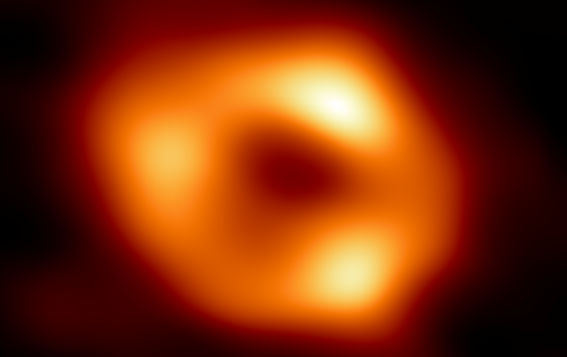Photography is irrefutable proof of its existence. The supermassive black hole, Sagittarius A*, already has a face
An international team of researchers has captured the first historic image of Sagittarius A*, the supermassive black hole at the center of the Milky Way.
This result constitutes overwhelming evidence that the object is indeed a black hole and provides valuable clues about the workings of these giants, which are believed to reside at the center of most galaxies.
The image was taken by a global research team, the Event Horizon Telescope (EHT) Collaboration, using observations with a worldwide network of radio telescopes, which function as a virtual Earth-sized telescope.
The results of the EHT team are released today, Thursday, May 12, in a special edition of The Astrophysical Journal Letters.
About Sagittarius A*: Its mass is equivalent to about four million suns, in a very small volume. Its diameter is about 23.5 million km. That’s tiny talking about cosmic objects of this mass. Consider that the Milky Way itself is 100,000 light-years wide and 1,000 light-years thick. It is located according to the latest estimates, specifically 25,640 light-years from the Solar System.
An Earth-sized telescope
While we can’t see the black hole itself because it’s completely dark, the glowing gas around it reveals a telltale signature: a dark central region (called a “shadow”) surrounded by a glowing ring-shaped structure. The new view captures light deflected by the black hole’s powerful gravity, which is four million times more massive than our Sun.
«We were surprised at how well the ring size matched with the forecasts of Einstein’s General Theory of Relativity said Geoffrey Bower, EHT project scientist, Institute of Astronomy and Astrophysics, Academia Sinica, Taipei.
“These unprecedented observations have greatly improved our understanding of what is happening at the center of our galaxy and offer new insights into how these giant black holes interact with their surroundings.” The EHT team’s results are published today in a special edition of The Astrophysical Journal Letters. .
As the black hole is about 27,000 light-years from Earth, it appears to us to be about the same size in the sky as a donut on the Moon. To get an image, the team created the powerful EHT, which joined eight existing radio observatories around the planet to form a single “Earth-sized” virtual telescope.
The EHT observed Sgr A* over several nights, collecting data for many hours at a time, similar to using a long exposure time on a camera.
The effort was made possible by the ingenuity of more than 300 researchers from 80 institutes around the world that together make up the EHT Collaboration. In addition to developing complex tools to overcome the challenges of Sgr A* imaging, the team worked rigorously for five years, using supercomputers to combine and analyze their data, while compiling an unprecedented library of simulated black holes to compare with observations.
